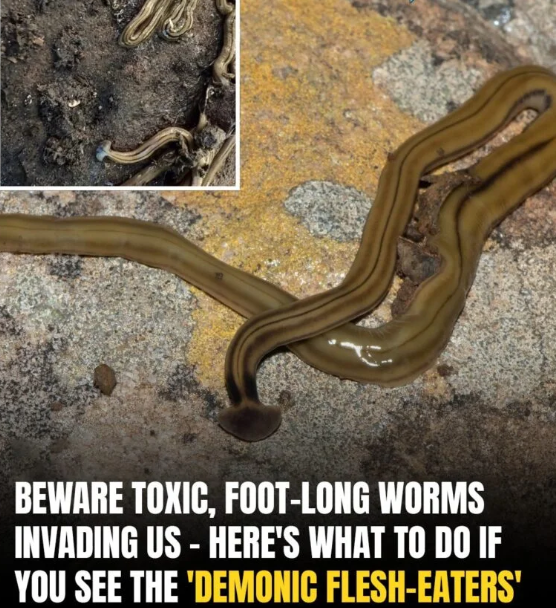North Texas is under siege by a slimy, foot-long invader straight out of a horror flick. Hammerhead flatworms, dubbed “demonic” by terrified residents, are crawling out of the ground in droves after weeks of heavy rain. With their eerie, hammer-shaped heads and toxic mucus, these Southeast Asian natives are wreaking havoc on local ecosystems and sparking panic from Dallas to Houston. Here’s the lowdown on these creepy crawlers and how to deal with them.
A Nightmare Unearthed
The deluge in North Texas, including storms tied to Hurricane Beryl’s remnants, has flushed hammerhead flatworms (Bipalium kewense) from their underground lairs onto driveways, porches, and gardens. Keller resident Adam Ingle described his encounter to NBC DFW: “It was terrifying, like these are truly the end times—even the worms are demonic.” At up to 15 inches long, with honey-colored bodies and one to five dark stripes, these flatworms sport a half-moon head resembling a hammerhead shark, making them unmistakable.
Viral TikTok videos capture the invasion’s eerie vibe: one shows a wriggling mass on wet soil, like miniature Tremors monsters, while another features a lone worm slithering across an envelope. “It’s like something out of a sci-fi movie,” a commenter noted. The Texas Invasive Species Institute (TISI) reports hundreds of sightings in Dallas, Tarrant, and Smith counties, with clusters in Houston, Austin, and coastal areas, fueled by the worms’ love for hot, humid climates.
Why They’re a Problem
Hammerhead flatworms aren’t just creepy—they’re ecological wrecking balls. Native to Southeast Asia and introduced to the U.S. in the late 1800s via imported plants, they’ve spread across states like Texas, Florida, Georgia, and even New York. Their key crimes:
-
Earthworm Predators: These worms hunt earthworms, vital for soil aeration and nutrient recycling. By decimating earthworm populations, they threaten gardens, crops, and forests. “Earthworms are crucial for soil health,” said Lamar County AgriLife Extension Agent Jessica Humphrey.
-
Toxic Mucus: They secrete tetrodotoxin, a neurotoxin used to paralyze prey. While not lethal to humans, it can cause skin irritation if touched and nausea in pets that eat them. “The likelihood of harm is low, but don’t let kids or pets ingest them,” entomologist Theresa Dellinger told Popular Mechanics.
-
Parasite Carriers: Some carry parasitic nematodes, which can cause abdominal angiostrongyliasis in humans, with symptoms like fever and abdominal pain.
-
Regeneration Superpower: Chop one in half, and you’ll get two worms. Their ability to regenerate via fragmentation makes them nearly impossible to kill by cutting, amplifying their invasiveness.
Despite claims on X labeling them “parasitic” or “flesh-eating,” these worms aren’t true parasites or human flesh-eaters. A post calling them “infecting humans” is misleading—they pose indirect risks via parasites, not direct infection.
How to Fight Back
Spot a hammerhead worm? Don’t panic, but don’t grab a shovel either. Here’s how to safely eliminate them, per TISI’s Ashley Morgan-Olvera:
-
Don’t Cut Them: Slicing creates more worms. “If you chop it into two pieces, you get two worms,” Morgan-Olvera warned KHOU.
-
Use Gloves or Tools: Avoid bare hands to prevent skin irritation from their toxic mucus. Use gloves, a stick, or a paper towel to pick them up.
-
Kill with Care: Place the worm in a sealed plastic bag or container with:
-
Salt
-
Vinegar
-
Citrus oil (like orange essence)
-
Hand sanitizer or soapy water Then freeze it overnight or leave it in direct sunlight for hours to ensure it’s dead.
-
-
Wash Thoroughly: After handling, wash your hands with warm, soapy water, then rinse with alcohol or hand sanitizer.
-
Report Sightings: Snap a photo and send it with location coordinates to invasives@shsu.edu to help TISI track their spread.
Morgan-Olvera told USA Today these worms are entrenched in Texas, with 351 confirmed sightings since 2000, the highest in the U.S. Reporting helps researchers understand their range, especially as climate change and wetter conditions may boost their numbers.
Myths vs. Facts
Social media is rife with exaggerations. A post on X claimed China sent these worms to “destroy our crops,” but there’s no evidence supporting this conspiracy. The worms likely arrived via trade routes, not as bioweapons. Another post hyped their “neurotoxins” as a major human threat, but experts clarify the risk is minimal unless mucus enters eyes or mouths. “They’re not demonic, just invasive,” Morgan-Olvera told The Dallas Morning News.
The Bigger Picture
Hammerhead flatworms have been in Texas for decades, first noted in Beaumont in the 1990s, but North Texas is seeing a surge due to recent rains. They thrive in mulch, nurseries, and greenhouses, hitchhiking on plants. With no natural predators and no known baits that spare earthworms, control relies on vigilant residents. “They’re here to stay,” Morgan-Olvera admitted to Chron.
For North Texans like Adam Ingle, the sight of these “miniature monsters” is unnerving, but armed with the right tools—gloves, salt, and a Ziploc bag—you can fight back. Keep your eyes peeled after rain, protect your garden, and help TISI track this slimy scourge. Texas has faced fire ants and feral hogs; we can handle these worms too.


